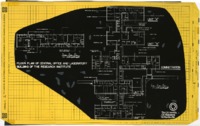
Rudolf Hermann Collection
Dublin Core
Identifier
Rudolf Hermann Collection
Title
Rudolf Hermann Collection
Description
Rudolf Hermann was born in Leipzig, Germany, and he studied at the University of Leipzig and at the Aachen Institute of Technology. He first started working with wind tunnels in 1934 when Professor Carl Wieselsberger engaged him to work at Aachen on development of a supersonic wind tunnel. On January 6, 1936, Dr. Wernher von Braun visited Dr. Hermann to arrange for use of the Aachen supersonic wind tunnel for Army problems. On April 1, 1937, Dr. Hermann became Director of the Supersonic Wind Tunnel at the Army installation at Peenemünde. Results from the Aachen and Peenemünde wind tunnels were crucial in achieving aerodynamic stability for the A-4 rocket, later designated as the V-2. The Allied air raid on Peenemünde on August 17, 1943 accelerated plans to build a Mach 10 “hypersonic” wind tunnel facility; Dr. Hermann served as the director of this new facility.
As World War II drew to a close in Europe, Dr. Hermann and his associates ignored Hitler’s destruction orders and preserved their wind tunnel documents and components, which were then acquired by the advancing American forces. After being brought to the United States through Operation Paperclip, Dr. Hermann became a consultant to the Air Force at its Wright Field in November 1945. In 1951, he was named a professor of Aeronautical Engineering at the University of Minnesota. In 1962, Dr. Hermann became the first Director of the Research Institute at the University of Alabama in Huntsville (UAH), a position he held until he retired in 1970.¹
¹Lundquist, Charles A. and Anne M. Coleman. "Rudolf Hermann, Wind Tunnels and Aerodynamics," 2006 57th IAC, Valencia, Spain (2-6 October 2006).
As World War II drew to a close in Europe, Dr. Hermann and his associates ignored Hitler’s destruction orders and preserved their wind tunnel documents and components, which were then acquired by the advancing American forces. After being brought to the United States through Operation Paperclip, Dr. Hermann became a consultant to the Air Force at its Wright Field in November 1945. In 1951, he was named a professor of Aeronautical Engineering at the University of Minnesota. In 1962, Dr. Hermann became the first Director of the Research Institute at the University of Alabama in Huntsville (UAH), a position he held until he retired in 1970.¹
¹Lundquist, Charles A. and Anne M. Coleman. "Rudolf Hermann, Wind Tunnels and Aerodynamics," 2006 57th IAC, Valencia, Spain (2-6 October 2006).
Collection Tree
- Space Collections
- Rudolf Hermann Collection
